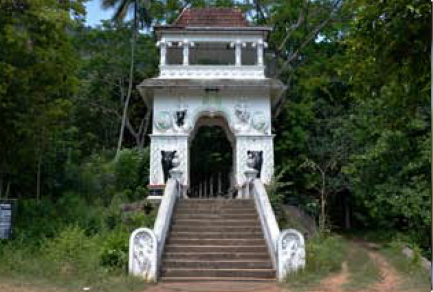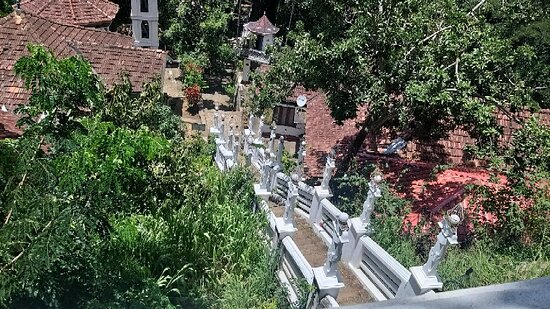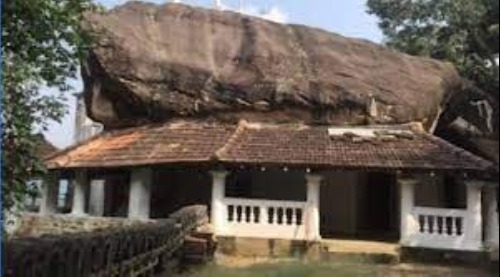Bambaragala Raja Maha Viharaya – cave temple with serene vistas
By Arundathie Abeysinghe

Situated in the village of Henagahawela in Teldeniya, Kandy, Bambaragala Rajamaha Viharaya is a cave temple situated at the summit of a rock surrounded by spectacular views of Victoria Reservoir and Knuckles Mountain Range.
History of the temple dates to pre-Christian era and the caves had been donated to Maha Sangha (Buddhist monks). According to *Professor Senarath Paranavitana, the inscription in *Brahmi script refers to the gifting of this cave by “Datta, the wife of the Pocani King”, Naga.
According to the inscription: “The Cave Indrasala (meaning a hall for the community) – given for the monks”. During the past, these caves had been the abode of ascetic monks. At present, the second cave is used by novice monks as an extra accommodation.
The majority of the current constructions had been carried out during King Keerthi Sri Rajasingha’s era (1747-1782 AD). The caves of the Temple had been occupied by ascetic monks prior to that date according to the rock inscription below the drip ledge of the second cave behind the main boulder.

There are rock cave hermitages (in Sinhala “lenas”) with drip ledges. According to Professor Paranavithana (Paranavitarna, Senarath, Inscriptions of Ceylon 1970. Vol. I p. 63.), the inscriptions found at this site date back to the 2nd and 3rd centuries BC.
There is a recently-built torana (arched entrance) with a steep flight of 164 stone steps to reach the rock temple. The Temple can be sited approximately half-way up during the ascent. At the summit of the last flight of steps, there is a natural archway formed by two huge boulders and the smaller boulder leans heavily against the larger boulder forming a peaked entrance-tunnel that ultimately opens to the extensive courtyard of the Temple, a unique feature. The large boulder comprises the elongated cave that forms the shrine room. The cave has a built-up front wall as well as an open *verandah that is protected by a roof. Another distinctive feature of the Temple is the verandah that runs alongside the length of the cave before winding around the furthest section of the boulder and stops in several steps which lead to a second cave that is situated at a lower level.

There is a large recumbent Buddha image as well as a smaller sedent image of the Buddha within the main cave. There are murals of *Jataka stories on the walls of the cave and the ceiling has lotus flower designs, similar to many ceilings of temples in Sri Lanka. The intricate artwork and murals are done according to a distinct *Kandyan Period artwork carried out under the patronage of King Keerthi Sri Rajasinghe.
The area surrounding Bambaragala Raja Maha Viharaya is home to a rich biodiversity of indigenous flora and flora; large herds of deer (Axis axis ceylonensis), monkeys (Trachypithecus vetulus) as well as diverse endemic birds. Pettigala Rock (also known as Pethiyagala, elevation 760 meters) is located on the summit of Bambaragala Mountain where the Temple is located.

Location – Approximately 21 kilometers from Kandy City
Directions: From Kandy travel along Kandy – Mahiyangane – Padiyatalawa Road towards Digana, after passing Digana travel towards Bambaragala Raja Maha Viharaya situated in Henagahawela Village in Teldeniya, Kandy.
As Bambaragala Raja Maha Viharaya is a Buddhist Temple, a venerated site of worship, it is necessary to maintain its serene edifying atmosphere when visiting the Temple as well as its environs including the surrounding hiking area. It is also necessary to dress modestly in appropriate attire and walk barefoot inside the temple premises as it is considered a sign of respect similar to visiting Buddhist Temples in Sri Lanka.
- Brahmi inscriptions – The earliest writing system developed in India after the Indus script and considered as an influential writing system. All modern Indian scripts as well as several hundred scripts that are in South Asia, Southeast and East Asia are derived from Brahmi.
- Jataka stories – These are extremely popular stories depicting the former lives of the Buddha.
- Kandyan Period – Kandyan Period covers the history of Sri Lanka from 1597-1815. Kandyan Kingdom was the last kingdom in Sri Lanka.
- Professor Senarath Paranavitana (1896 – 1972) – Pioneering archeologist and renowned epigraphist of Sri Lanka, his works dominated Sri Lankan archaeology as well as history during the middle-part of the 20th century. In 1940, he assumed duties as the Commissioner of Archeology.
- Verandah – A roofed platform along the outside of a house and extends across the front and sides of a building, at times partly enclosed by a railing. Derived from “varanda” in Hindi, this type of porch had been initially constructed by British Colonials observing buildings in India. According to legends, the word has its origins from Portuguese Colonial Era as the word had been used by the Portuguese too.
Image courtesy: kandyguide.info,tripadvisor.com & santani.lk







